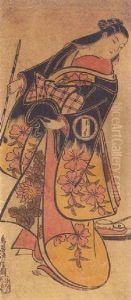Torii Ii Kiyonobu Paintings
Torii Kiyonobu I was a significant figure in the world of Japanese ukiyo-e art, particularly known for his pioneering role in the development of the Torii school. Born in 1664, Kiyonobu was instrumental in establishing the visual style associated with Kabuki theater advertising and actor portraits, which became a hallmark of the Torii school's output. His work is characterized by bold lines, vibrant colors, and dynamic compositions, capturing the energy and drama of Kabuki theater. Kiyonobu's artistry played a crucial role in the evolution of ukiyo-e from primarily genre and landscape subjects to the inclusion of actor prints and theatrical scenes.
Kiyonobu's contributions to the ukiyo-e genre were not limited to Kabuki-related imagery; he also produced works featuring courtesans and other subjects typical of the floating world. However, it was his dynamic actor prints that most vividly captured the public's imagination, helping to cement the popularity of ukiyo-e art throughout Japan. Kiyonobu's style was influential in defining the aesthetic direction of the Torii school, and he trained several artists who continued his legacy, including Torii Kiyonobu II.
Throughout his career, Kiyonobu was closely associated with the Kabuki theaters of Edo (modern-day Tokyo), and his posters and actor prints were highly sought after by the theater-going public. His work not only served as promotional material for Kabuki performances but also as cherished collectibles for fans of the actors depicted. Kiyonobu's innovative approach to printmaking, including the use of thick lines and a dramatic use of color, set new standards in the art form and influenced subsequent generations of ukiyo-e artists.
Torii Kiyonobu I passed away in 1729, leaving behind a rich legacy that had a lasting impact on Japanese art. His pioneering efforts in the Torii school helped lay the groundwork for the flourishing of ukiyo-e during the Edo period, and his influence can be seen in the works of later ukiyo-e masters. Today, Kiyonobu's prints are highly valued by collectors and art historians alike, serving as a testament to his artistic vision and his pivotal role in the history of Japanese art.






